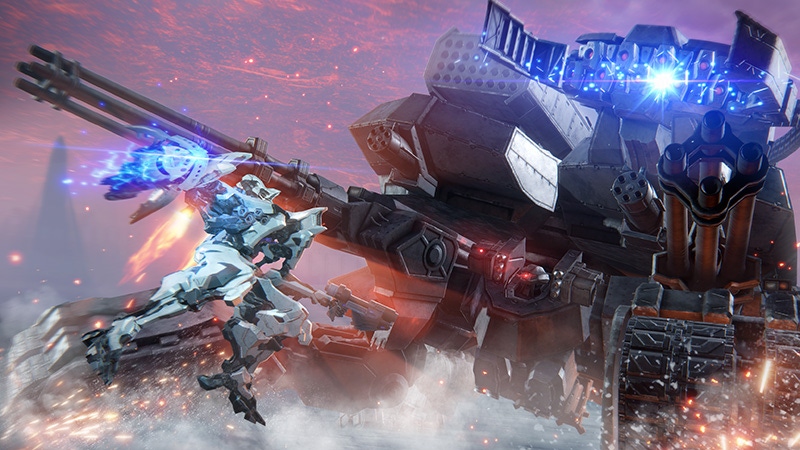Armored Core 6 and the art of rebuilding the mech-driven series
Armored Core 6 game director Masaru Yanamura and producer Yasunori Ogura discuss FromSoftware's return to the cult-classic series.

Before the groundbreaking releases of Demon's Souls, Sekiro: Shadows Die Twice, and Elden Ring, developer FromSoftware made its name with the giant robot action series Armored Core. With a cult-following dating back to the original PlayStation, fans embraced the dystopian settings and the fast-paced mech combat. In the period since the studio's massive pivot to the Souls sub-genre that it founded, the Armored Core series went on hiatus.
Following last year's reveal of the long-awaited return to the franchise, Armored Core 6: Fires of Rubicon, developers have speculated how this revival of the series will incorporate many of the key learnings that FromSoftware have cultivated from their recent hits.
We recently got to play the opening hours of Fires of Rubicon, and after interviewing game director Masaru Yamamura and producer Yasunori Ogura, we learned that Armored Core 6 isn't so much of a Souls-style take on the mecha action franchise as many thought. This revival is all about refining the franchise's tactical and free-form approach to giant robot combat, dystopian sci-fi storytelling, and, simply put, letting Armored Core stand on its giant own two feet.
Reviving FromSoftware's cult series
As a reboot and fairly loose continuation of the story from previous games, Armored Core 6: Fires of Rubicon sticks close to the series' core conceit of mech pilots taking on challenging and morally ambiguous missions for the highest bidder
Playing as a mercenary who pilots a massive mech, you take on jobs with warring corporations and rebel groups on the planet of Rubicon 3 following a global disaster. By taking on different missions from these factions, the protagonist will expand their arsenal of weapons and mech parts to take on increasingly more dangerous jobs, leading to critical moments that will decide the fate of the planet and the factions looking to wrest control.
From the opening hours, it was evident that the latest game is consistent with earlier entries, which focus on a mission-based structure with key narrative details and story beats fed to you through mission briefings, radio chatter, and key events. This return to an indirect and passive storytelling style—different from the likes of Elden Ring or Dark Souls—was intentional, according to the developers. Yamamura explained that previous Armored Core games had "complicated stories" that "weren't easy to follow," and there's been a deliberate effort to pursue clarity this time around.

"We want players to understand what they're fighting for and why they're fighting," he said. From Software also put a lot of investment in the in-mission radio chatter, so players could "form interpersonal bonds with characters," something Yamamura said hadn't been explored in previous games.
In many ways, it is a throwback to classic Armored Core but fixed up with the sprawling scope and detailed presentation in visuals that FromSoftware has refined in recent years.
Speaking with the developers at FromSoftware, they took some time to clear the air on the speculation from fans following the game's reveal regarding whether Armored Core would be designed around the Souls formula. Yamamura stressed that this game was an opportunity to revisit the series and update its framework for modern times.
"We saw the debate online from fans about what type of game this would be [when it was announced] and took it to heart," said Yamamura "First and foremost, we want to convey that this is a true Armored Core game, and that's what we wanted to make."
"At the same time, however, we wanted to incorporate our know-how and our experience from over the last ten years of game dev on other projects into this new Armored Core in a way that makes sense for the series. We want to be able to cater to both AC fans and fans of our other projects."
While Armored Core 6 is very much in tune with earlier entries, it undoubtedly has some influences with games like Sekiro and Dark Souls when it comes to offering tight and smoother controls and a more tactical approach to engaging enemies. With the developers referring to the combat in AC6 as "Omni Directional Action" (the flow of horizontal ground combat and vertical action), there's a constant need to keep momentum and adapt to enemy tactics, all while putting on pressure to stagger opponents to deal critical damage.
From my hands-on, it was clear that Armored Core 6 had solved a recurring issue with the series, which was the unique yet still cumbersome control scheme from previous games. Armored Core 6 features a revamped and streamlined setup, offering greater precision and control. This made the action feel very responsive and tight with its movement, coupled with a generous lock-on system with soft and hard targeting options – which admittedly took some getting used to.
According to Ogura, the revamped lock-on system was inspired by their previous efforts on the Souls series but still influenced by newer games: "We're doing something to appease both traditional fans of the series and those looking for something that has some influence from our other projects."
Building the dystopian planet Rubicon 3
While Armored Core 6 brings back the series's stand-alone mission structure which whisks you away to different areas of the planet, the game still possesses an immense scope and variety of settings that give each mission a bespoke feel. Some moments echoed that of the sprawling landscapes of Elden Ring, but within the context of a mech game, it becomes a large playground to let loose with your gear.
A stand-out mission for me was set in a desert during a sandstorm, where I had to chase after a roaming giant walking mech with a powerful laser cannon on its back. As I darted through the desert after the giant mech, taking down smaller targets along the way, piercing blue beams of energy would rip through the haze, even a slight graze causing massive damage. Once I caught up to the target, I had to scale up across its leg and onto its larger body, using my mech's boosters and jets to reach the top and face down its weak spot.
It was a remarkable mission that brought the best of the Armored Core series' spectacle moments with the tension of high-difficulty encounters from Sekiro or Elden Ring. When paying attention to the details, these missions are filled with lore and other intriguing points of interest – some of which go into very dark territory that calls out the bleak and ruthless setting of Rubicon 3. According to the developers, Armored Core 6 will feature key moments where players can change the course of the story by choosing a side, which will lead to different events and endings.

Despite its story and characters mainly staying on the periphery, Armored Core 6 still has a strong atmosphere to it, which leans heavily into a dystopian sci-fi vibe. During my interview, the developers shared that the latest technology has given the Armored Core series greater detail and fleshed out its world in ways that weren't possible in older games.
"We want to be able to focus on the mech fantasy, and one aspect that new technology has helped with our vision of Armored Core is the graphical fidelity of our mechs and the world itself," said Yamamura "Previously, games in the series had some fairly limited customization options for their mechs, but now, we have a greater degree of detail when it comes to applying textures, different colors, and weathering effects when showing battle damage during heavy combat."
"Overall, it helps bring the mech fantasy to life for fans in ways other games couldn't."
FromSoftware has been working on an Armored Core sequel since 2018
Armored Core 6: Fires of Rubicon is so far shaping up to be an exciting, and very challenging, return for the franchise. This revival could potentially be the start of a brand new phase for developer FromSoftware, juggling both Souls-style action-RPGs and new mecha action games.
According to Ogura, revisiting Armored Core was always a goal for the studio, even after the monumental success of games like Elden Ring and Dark Souls.
"The Armored Core series is something that we've always held dear, and it was always a matter of when, and not if, when it came to making another game," said Ogura. "Many of the FromSoftware staff, Miyazaki included, have wanted to make another AC game for a long time. But we're not an enormous studio, and a large part of trying to proceed with this game was getting enough resources and finding the right timing."
"In 2018, Miyazaki had started to set the groundwork for that, figuring out what an AC game would be like if we made it today, building that worldview, and figuring out what people identified with AC the most," Ogura continued. "In 2019, after Sekiro was released, Yamamura took over as director for AC6 and worked on those foundations forward. Armored Core has always been a part of the lifeblood and identity of FromSoftware, so we've always wanted to return to it and are glad we now have that opportunity."
What's especially interesting about this return to Armored Core is that its key developer went through a significant reinvention since the franchise's last entry, 2013's Armored Core V: Verdict Day. The cult-favorite mech series is now working with a larger budget, made by a team of developers that has influenced modern action and role-playing games in fundamental ways.
With Armored Core 6, the long-dormant franchise could be a position to not only show newcomers and veterans what made the series such a cult-favorite, but also prove that the long-running series can have its own reinvention along with its key developer.
Read more about:
FeaturesAbout the Author
You May Also Like









